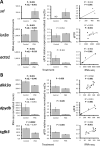Phoenixin-14 alters transcriptome and steroid profiles in female green-spotted puffer (Dichotomyctere nigroviridis)
- PMID: 35676522
- PMCID: PMC9177834
- DOI: 10.1038/s41598-022-13695-z
Phoenixin-14 alters transcriptome and steroid profiles in female green-spotted puffer (Dichotomyctere nigroviridis)
Abstract
Phoenixin (PNX) is a highly conserved, novel hormone with diverse functions, including hypothalamic control of reproduction, appetite modulation, and regulation of energy metabolism and inflammation. While some functions appear conserved across vertebrates, additional research is required to fully characterize these complex pleiotropic effects. For instance, very little is known about transcriptome level changes associated with PNX exposure, including responses in the hypothalamic-pituitary-gonadal (HPG) axis, which is critical in vertebrate reproduction. In addition, the PNX system may be especially complex in fish, where an additional receptor is likely present in some species. The purpose of this study was to assess hypothalamic and ovarian transcriptomes after PNX-14 administration in female vitellogenic green-spotted puffer (Dichotomyctere nigroviridis). Steroid-related changes were also assessed in the liver and blood plasma. Hypothalamic responses included pro-inflammatory signals such as interleukin 1β, possibly related to gut-brain axis functions, as well as suppression of cell proliferation. Ovarian responses were more widely downregulated across all identified pathways, which may reflect progression to a less transcriptionally active state in oocytes. Both organs shared regulation in transforming growth factor-β and extracellular matrix remodeling (periostin) pathways. Reproductive processes were in general downregulated, but both inhibiting (bone morphogenetic protein 15 and follistatin) and promoting (17-hydroxyprogesterone) factors for oocyte maturation were identified. Select genes involved in reproduction (vitellogenins, estrogen receptors) in the liver were unresponsive to PNX-14 and higher doses may be needed to induce reproductive effects in D. nigroviridis. These results reinforce the complexity of PNX actions in diverse tissues and highlight important roles for this hormone in regulating the immune response, energy metabolism, and cell growth.
© 2022. The Author(s).
Conflict of interest statement
The authors declare no competing interests.
Figures







References
Publication types
MeSH terms
Substances
Grants and funding
LinkOut - more resources
Full Text Sources

